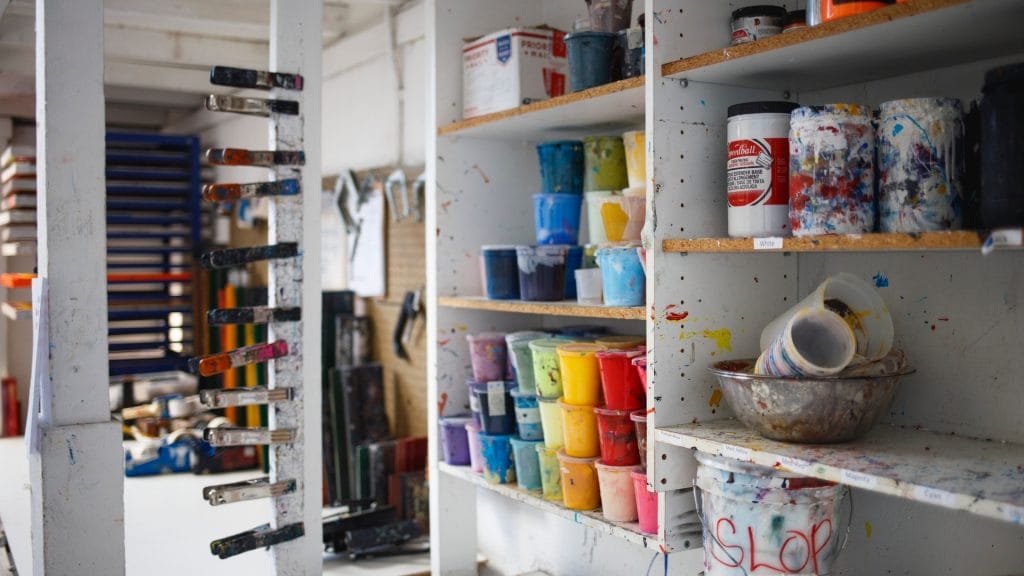For all your painting projects around the house, it’s good to keep a few cans of mixed paint lying around. You never know when you’ll need to do a little touch-up to keep your home looking good as new. But the question is, how long can your cans of paint last?
Assessing Your Storage Conditions
 The key to keeping your paint fresh and usable is storing it properly. Unopened latex and water-based acrylic paints can last up to 10 years if stored in the right conditions, while oil-based paints can last for up to 15. Once you open up the can, however, you’re exposing the paint to oxygen, and the chemical makeup will start to change. However, open cans of paint aren’t an immediate write-off. It’s just about storing them in the right conditions to get the most longevity out of them.
The key to keeping your paint fresh and usable is storing it properly. Unopened latex and water-based acrylic paints can last up to 10 years if stored in the right conditions, while oil-based paints can last for up to 15. Once you open up the can, however, you’re exposing the paint to oxygen, and the chemical makeup will start to change. However, open cans of paint aren’t an immediate write-off. It’s just about storing them in the right conditions to get the most longevity out of them.
As a general rule, paint shouldn’t be stored in your garage, especially if you live in a region that has distinct seasons. Paint that has undergone repeated cycles of freezing and thawing is much more likely to go bad. While it is possible to freeze paint until you’re ready to use it, constant freezing and thawing contribute to chemical breakdown.
 In fact, any exposure to extreme temperatures—hot, cold, or humid—is bound to make the paint go bad after a prolonged period. Even sealed cans of paint can suffer from rapid temperature changes. That’s why experts recommend against storing cans of paint in your garage, shed, or on your deck. You’re better off stowing your paint cans in a cool – not cold! – dry place. Somewhere like the utility closet would be a good spot, whereas the cold cellar would be too, well, cold.
In fact, any exposure to extreme temperatures—hot, cold, or humid—is bound to make the paint go bad after a prolonged period. Even sealed cans of paint can suffer from rapid temperature changes. That’s why experts recommend against storing cans of paint in your garage, shed, or on your deck. You’re better off stowing your paint cans in a cool – not cold! – dry place. Somewhere like the utility closet would be a good spot, whereas the cold cellar would be too, well, cold.
You should also seal your can up as tight as possible because oxygen is the enemy of paint—at least if you still want to use it. Try to avoid warping the lid when you open the can. Your best bet is to open the can with an actual paint can opener rather than a screwdriver, and when closing, use a rubber mallet, not a hammer. If you don’t have a rubber mallet—it’s okay, not everybody does—you can lay a piece of wood over the lid and hit it with the hammer to seal.
Keep paint away from the rim, as this can make it hard for the lid to seal properly. You can do this by using a paint spout instead of pouring right from the can. This will help you get an airtight seal on the can and keep your product fresh.
When Paint Goes Bad

What are the symptoms of a rotten can of paint?
Unusual Texture: It’s perfectly normal for cans of paint to develop a thin, filmy layer over top of its contents. The film should be the consistency of a delicate membrane, and it should be easy to puncture simply by dipping a finger or a paintbrush into the can. You may find that the film is rubbery and thick for some opened cans of paint. You can remove this, but if the product underneath is chunky, gelatinous, or fully solidified, the paint is past use. There may be small lumps, but often a good stir will be enough to reincorporate them. If there are lumps that you can’t get rid of, the paint will probably not look good on the walls.
Funky Smell: If you crack the lid and find that your paint has taken on an odor, it’s probably time to let it go. Paint has a strong chemical scent, but it shouldn’t smell rancid, sour, moldy, or gross. If you would use any of those words to describe the smell of your paint, it’s likely gone off.
Before you start lathering your paint all over the walls, be sure to do a patch test. Sometimes you can’t tell if the paint is off until you see it applied to a surface! Give your can of paint a thorough stirring—at least five minutes of vigorous agitation—to reincorporate all the ingredients. Then, paint a swatch on a piece of cardboard. If the paint goes on smoothly and appears normal, you’re in the clear. If, however, the paint looks lumpy, grainy, or separated even after stirring, its chemical makeup has likely altered during storage, and it’s no longer usable. Time to head back to the store and get a new can!
Now that you know how to store your goods properly, what will you create? Connect with us today for more great design and remodeling ideas.





